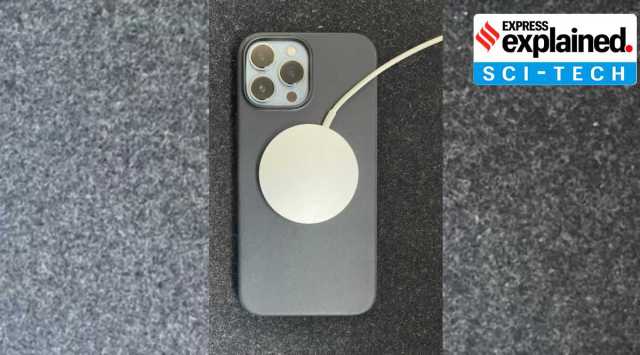- India
- International
Explained: Why EU rules on common chargers could result in iPhone without charging ports
A look at why the European Union wants every phone to have the same charger, and what the directive means for the tech industry, including Apple.
 If the European Commission moves ahead with its plans to make common chargers mandatory on all smartphones, the move would hurt Apple more than its rivals including Samsung, OnePlus and Xioami.
If the European Commission moves ahead with its plans to make common chargers mandatory on all smartphones, the move would hurt Apple more than its rivals including Samsung, OnePlus and Xioami.The European Commission (EC) Thursday proposed a new rule that will force all manufacturers of mobile phones and other electronics to adopt a single universal charging solution. An 18-page directive clearly stated that a common charger for all brands “would benefit consumers and reduce electronic waste”. But if there is one brand that will be impacted the most by the move, it would be Apple which will be forced to redesign its iPhones from ground up to comply with the rules.
We explain why the EU wants every phone to have the same charger and what the directive means for the tech industry.
EU proposes Universal Charger for all phones
For years, the European Parliament has been pushing for a common charger for mobile phones. But this week the European Commission, the EU’s executive branch, announced a new plan to standardise charging ports for consumer electronics devices like smartphones and tablets being sold within the 27-nation bloc. The new proposal appears to be more forceful and, once adopted, will make it mandatory to use USB-C as the common standard for almost all phones and other small mobile electronic devices. The legislative proposal will be first debated by the European Parliament to become a law. The parliament has already voted in favour of new rules on a common charger in 2020.
Device manufacturers would have only 24 months to comply with the rules and make changes in their products accordingly.
“European consumers were frustrated long enough about incompatible chargers piling up in their drawers,” Margrethe Vestager, the European Commission’s executive vice-president, said in a press release. “We gave industry plenty of time to come up with their own solutions, now time is ripe for legislative action for a common charger.”

The revised Radio Equipment Directive proposal is aimed at favouring a common USB-C charging port that will be convenient for consumers but the move also reduces waste. The “directive” proposal would also establish a “harmonised” fast charging technology and that will prevent manufacturers from throttling charging speed. So when a consumer buys a device without a charger, proper guidelines need to be given about the charging standards their device supports. Unlike the Brazilian regulator which keeps insisting manufacturers bundle the charger inside the device box, the European Commission is in favor of unbundling the charger from new products. The move will affect smartphones, tablets, headphones, cameras, speakers and video game consoles.
What is USB-C?
USB stands for “Universal Serial Bus”, an industry standard for short-distance digital data communications. USB-C is the latest version of this standard and is symmetrical so that it can be inserted either way. The USB-C is a single cable that can transmit data, audio, video and power. For example, you can connect your laptop to an external monitor using a USB-C cable. This is much faster than USB 2.0.
Some of the most popular Android smartphones including Samsung Galaxy S21, Nintendo Switch, Dell XPS 13, MacBooks, and even iPad support USB-C. Half of chargers sold with mobile phones in the European Union in 2018 had a USB micro-B connector while 29 per cent had a USB-C connector and 21 per cent a Lightning connector, a Commission impact assessment study in 2019 found.
Why is the EU’s proposal to make a common charger port for all devices bad news for Apple?
Unlike Samsung which ships its Galaxy smartphones with USB-C ports, Apple uses its proprietary Lightning connector to charge the iPhone. The Lightning connector was introduced in 2012 with the arrival of the iPhone 5 and since then Apple has stuck to the Lightning connector on its most successful product, although its other products like the iPad Air 4 and recent MacBooks now use USB-C instead of Lightning as its standard connector. Even Apple’s latest iPhone 13 series uses the standard Lightning Connector for charging.
If the European Commission moves ahead with its plans to make common chargers mandatory on all smartphones, the move would hurt Apple more than its rivals including Samsung, OnePlus and Xioami.
For years, Apple has resisted the idea of putting the standard port in its devices, especially on the iPhone, perhaps the most successful product of the past decade. And there is a reason why the iPhone still supports the Lightning connector and not USB-C. By removing the Lightning connector from the iPhone means Apple will take a hit on its lucrative accessories business. There is an ecosystem around a Lightning Connector and killing it immediately will create an issue for the accessories makers, plus the move could be troublesome especially for consumers.
The Cupertino company has repeatedly warned that the EU proposal for a common charger would hurt “innovation” and create a mountain of electronic waste if consumers were forced to switch to new chargers. “Apple stands for innovation,” the company wrote in a 2019 feedback form opposing the initiative. “We want to ensure that any new legislation will not result in the shipment of any unnecessary cables or external adaptors with every device, or render obsolete the devices and accessories used by many millions of Europeans and hundreds of millions of Apple customers worldwide,” it added.
What will Apple do next?
Europe is a crucial market for Apple. But Apple does not make country-specific products. So don’t expect that strategy will change even if EU lawmakers will successfully standardise charging ports for devices like smartphones and tablets. Apple has two options: either switch the iPhone to USB-C or develop a portless iPhone instead.
According to tech site The Verge, the European Commission’s proposal is limited to standardised wired charging and not wireless charging. This means that if the iPhone goes fully wireless in the future, Apple does not have to add a USB-C port. That makes a way for Apple to ship with a port-less iPhone and get rid of wires completely. It is to be noted that the Commission’s proposal need to first get a nod from the European Parliament and Council, plus there is a two-year “transition period” that would allow Apple to launch a fully wireless and port-less iPhone.
Chances of the future iPhones without ports makes more sense and Apple is already hinting at a port-less future through MagSafe, the wireless charging system taking advantage of an array of magnets that snap the iPhone 12 or iPhone 13 Pro onto a MagSafe puck. This whole idea of MagSafe bypasses the need to have a Lightning connector, though iPhones still have that charging system but it no longer ships the wall adapter and wired earphones in the box.
In fact, past reports have claimed that Apple would ship the iPhone without ports and switch completely to wireless charging. Apple is not averse to drastic changes in the iPhone. For instance, it killed the 3.5mm headphone jack with the iPhone 7 and the entire smartphone industry followed the move and ditched the headphone jack from their flagship phones.
While Apple first embraced wireless charging by adding the Qi-based wireless inductive charging to its iPhone 8 and iPhone X in 2017, the truth is this technology is significantly slower than the old fashioned wall adapter. The iPhone 13 series, for instance, supports Qi charging of up to 7.5W and MagSafe wireless charging of up to 15W.
The OnePlus 9 Pro in contrast supports fast 50W wireless charging. Xiaomi recently announced a 100W wireless charger stand which can fully charge the 4,500mAh battery of the Mi Mix 4 in 28 minutes. So, yes, things are improving every year, though for now wireless charging is still in the initial phase.
Apple hasn’t succeeded with a standalone wireless charger yet. It tried its hands at building the AirPower wireless charger but eventually failed to ship the device citing technical challenges. Reports of a new wireless charging pad have been circulating for months, though it remains to be seen whether Apple manages to launch the product or if it will face the same fate as the AirPower.
Newsletter | Click to get the day’s best explainers in your inbox
More Explained
EXPRESS OPINION
May 02: Latest News
- 01
- 02
- 03
- 04
- 05











































